Home » Other Articles » Going Loco Index » Going Loco - February 2024 - Going Loco - February 2024
Going Loco - February 2024
23 FEBRUARY
Centenaries - As Far As The Eye Can See…
No 4079 Pendennis Castle turns 100 this year. We have a special event to celebrate it on 2 and 3 March – why not come along to celebrate?! We had another century event last year, celebrating the 100th Anniversary of the first Castle class locomotive – No 4073 Caerphilly Castle – being completed. There is another centenary next year – that of No 4079’s domination on the LNER / GWR locomotive interchange trials and her attendance at the Empire Exhibition in 1925. Plans for an event here are afoot too .… That’s a lot of centenary celebrations. But we aren’t the first to celebrate a centenary on the Great Western.
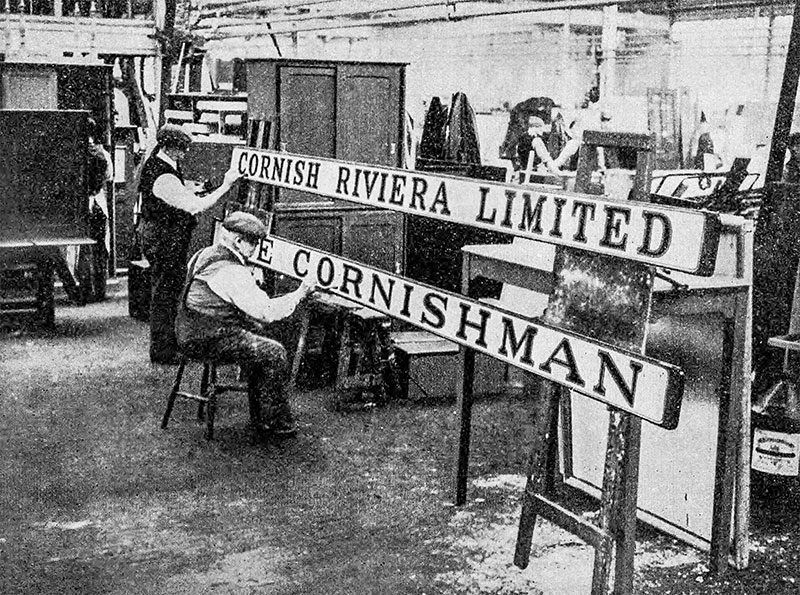
Signwriters painting carriage roof destination boards for the rebranded Cornish Riviera Limited and the new Cornishman trains. Photograph published in Great Western Railway Magazine, July 1935 edition
The Great Western celebrated their own centenary in 1935. There were a whole host of events that were conceived to celebrate this and promote the fact that they were basically still the same railway company that had been set up in the 1830s. A remarkable record in anyone’s book. A banquet was held in Grosvenor House Hotel in London for 1,100 people. There were a whole host of updates to reflect the forward looking nature of the company and the Art Deco design movement. Its sweeping streamlined lines, geometric patterns and polished metal and chrome defined the age and had become all the rage on the railways of the U.K. at the time.
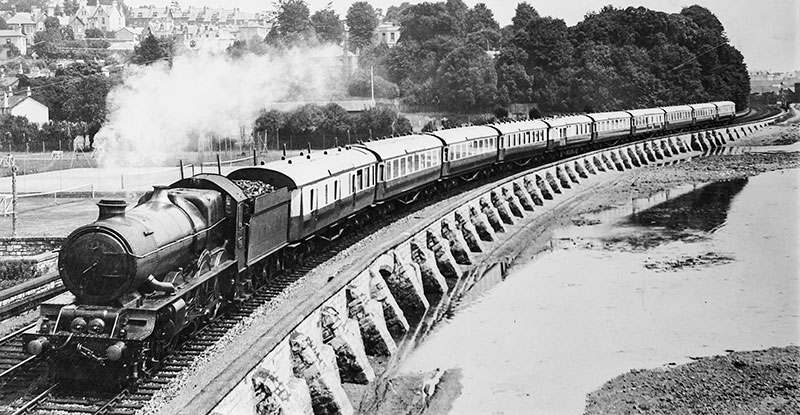
The complete ten-coach Centenary Cornish Riviera Limited, alongside the river Teign in Devon. Photograph in the Great Western Trust collection
We have already had a look at the only surviving Centenary coach, No 9635, which is in our collection, so why don’t we take a look at how the Great Western themselves celebrated their 100th birthday way back in 1935. Our source is the Great Western Railway Magazine via our legendary image and information guru, Photo Frank …
The magazine’s July 1935 edition introduced the new timetable for the summer holiday period:
“With the constantly increasing holiday traffic to Cornwall an entirely revised schedule has become necessary, and in this connection the ever-popular and widely-known Cornish Riviera express enters a new phase in its history. The traffic attracted to this famous service has, in past summers, severely taxed the carrying capacity of one train, and to meet the heavy requirements a companion express will be introduced, the two trains to be known, respectively, as The Cornish Riviera Limited and The Cornishman.
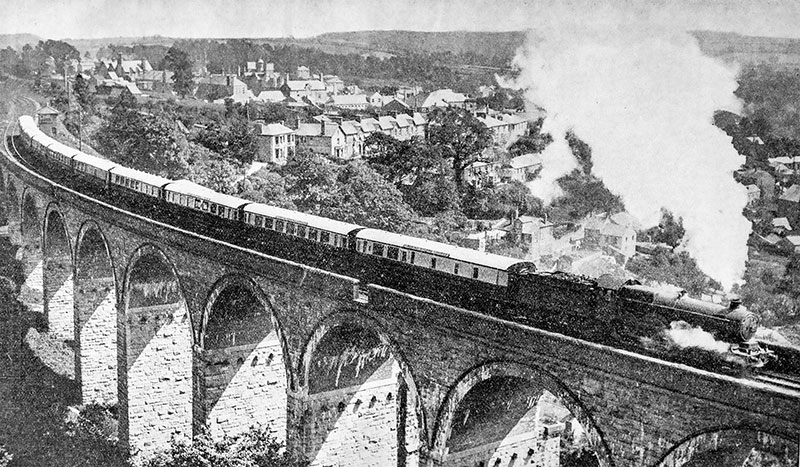
The Centenary Cornish Riviera Limited crossing St Austell viaduct in July 1935. Photograph published in Great Western Railway Magazine, August 1935 edition
“The Cornish Riviera Limited will leave Paddington at 10.30 am and Penzance at 10.0 am, and will carry reserved seat passengers only. From Mondays to Fridays it will run non-stop in each direction between Paddington and Truro (279 miles) and convey passengers for and from Truro, Falmouth, St Ives, and Penzance only. On Saturdays, the non-stop run from London will be extended to St Erth (299 miles), and the train will serve St Ives and Penzance only, passengers for Falmouth and Helston travelling by a relief express, leaving Paddington at 10.25 am.
“The Cornishman will cater for intermediate traffic not served by The Cornish Riviera Limited. It will run each week-day, and it virtually becomes the train it is designed to relieve. The down train will leave Paddington at 10.35 am and carry passengers for Newquay, St Erth, Helston, Penzance (due at 5.7 pm), and other Cornish stations. The up train will start at 10.20 am from St Erth, and call at Gwinear Road, Truro, Par, and Plymouth, from which point it will run without intermediate stop to Paddington, where it will be due at 4.50 pm.”

An O gauge model, by Kenard, of Centenary first class dining saloon and kitchen. This is one of a complete rake of Cornish Riviera Limited O gauge coaches recently donated to Didcot Railway Centre. The original of this vehicle is stored in the carriage shed at Didcot
Then the next month, the magazine described the carriages:
“The New Great Western Railway Cornish Riviera Trains
“The article on the Great Western Railway summer service in the July issue of the Magazine intimated that an important new passenger train, The Cornish Riviera Limited, would be put into service on 8 July, leaving Paddington at 10.30 am – the same time as the former Cornish Riviera Express. The rolling stock comprising this train has been constructed in the Company’s Swindon works. It is of a new style and reaches a very high standard in travelling comfort and amenities.

The kitchen side of the Kenard model of the Centenary diner. Note the five circular gas tanks in the underframe, for cooking
“There are in due course to be two such trains, providing a daily service in each direction. At the moment only one has been delivered, confining the use of the new stock from the London direction to Mondays, Wednesdays, and Fridays, the return journey of the new coaches being made on the alternate days. The new Cornish Riviera Limited carries booked seat passengers only, and runs non-stop to Truro* (279 miles) on weekdays, except Saturdays, when the down train makes its first stop at St Erth*, 299 miles from Paddington.
“Each of the new trains consists of ten coaches of the following formation:
• Brake Compo 36 seats
• Brake Compo 36
• Third Class 56
• Brake Third 16
• First and Third Class Compo 48
• First Class Saloon and Kitchen 24
• Third Class Dining Saloon 64
• Third Class 56
• Third Class 56
• Brake Third 16

The interior of the first class dining saloon in the Centenary diner, as built. Photograph published in Great Western Railway Magazine, August 1935 edition
“All the vehicles are 60 ft long and 9 ft 7 in wide, and have vestibule entrances with over hanging bow ends, which reduce the length of the gangway between the vehicles. The bodies are constructed with fire-proof floors and are completely encased with steel plating. They are carried on massive steel underframes mounted on pressed steel bogies of an improved design, which give very steady riding. The first class compartments are panelled in light quartered oak and walnut, with oval mirrors, and upholstered in various colour schemes in blue, green, and brown. The third class compartments are panelled in gaboon mahogany and walnut, with oval mirrors, the upholstery being in brown moquette.
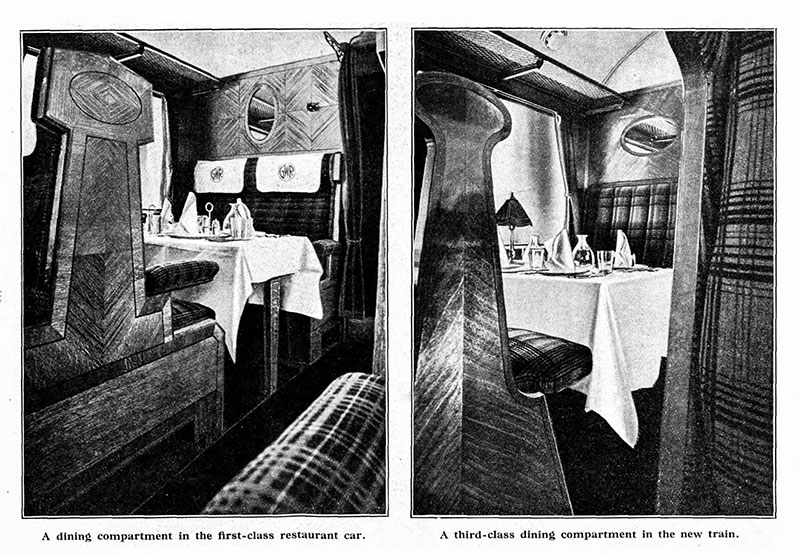
Interiors of the first class and third class dining bays in the Centenary trains. Photographs published in Great Western Railway Magazine, August 1935 edition
“The windows throughout the train are of extra large size, of the drop type, and are fitted with rayon curtains. The floor covering is of linoleum laid on felt, with carpets and rugs to match the upholstery. Accommodation for twenty-four passengers is provided in the first class restaurant car, which is finished in light quartered oak and walnut. The saloon seats are of the fixed pattern; they are upholstered in brown repp, and have loose, spring-filled cushions.

A Kenard O gauge model of a Centenary brake composite coach. This has a guard’s and luggage compartment on the left, then two first class compartments (blue curtains) and three third class compartments. Note the subtle difference in the widths between the windows of the first class compartments and the third class, giving more space in first. Following habits at the time, first class has one smoking and one no smoking compartment (triangular label), while third class has two smoking and one no smoking
“The kitchen, which is separated from the pantry by a serving vestibule, is lined with stainless steel sheeting and equipped with gas stove, plate warmer, and hot water circulator for supplying hot water to the sinks in the kitchen and pantry. Two refrigerator cup boards are fitted, being cooled by an electrically- operated refrigerating plant carried under the coach. The pantry contains accommodation for the storage of china, cutlery, etc, in addition to wine cupboards, sinks, and serving tables.
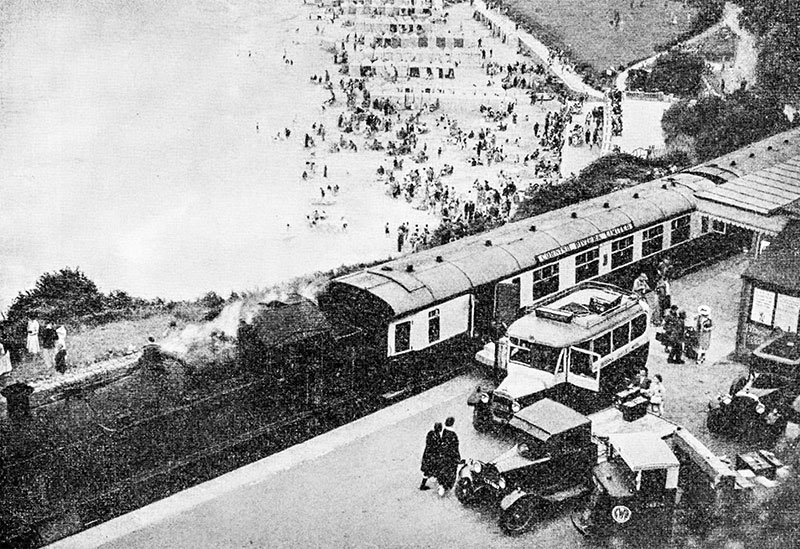
The arrival of the St Ives portion of the Cornish Riviera Limited is formed with one of the brake composite coaches. The small road motor (GWR terminology for buses) is to take passengers to the Tregenna Castle Hotel. The photograph was published in the Great Western Railway Magazine, September 1939 edition, titled “Literally at the seaside”
“The third class dining saloon, which is panelled in gaboon mahogany and walnut, accommodates 64 passengers, tip-up spring seats being arranged in groups of four on either side of the centre corridor. Passengers using this service will readily appreciate that they have accommodation fitting to the dignity of a new Cornish Riviera express which, in its performance, adds lustre to an already great tradition.”
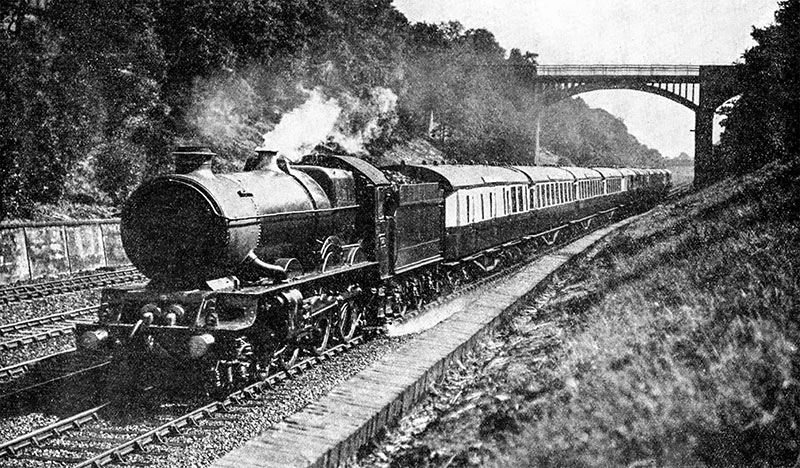
The Cornish Riviera Limited in Sonning cutting behind No 6022 King Edward III. Photograph published in Great Western Railway Magazine, July 1936 edition
Don’t you just love the language used in these old publications?! We of course are going to celebrate No 4079’s 100 by making some steam and noise, marketing a new beer and trying to gather 100 different Castle related items together including models, souvenirs and original nameplates being specially displayed from the Great Western Trust’s collection. Sounds like fun and I hope you can join us. The link for booking tickets can be found by clicking here:
https://didcotrailwaycentre.org.uk/product.php/161/pendennis-castles-100th-birthday-party
Thanks once again to Photo Frank and we will see you again next time!
* Although the train was advertised at non-stop, there was a stop, not at a station, for the engines to be changed after the four-hour journey from Paddi
16 FEBRUARY
The Other McAlpine Engine at Didcot
We have a famous locomotive that has the very great fortune to be associated with that towering figure of railway preservation – Sir William McAlpine. He of course was once the owner of our very own No 4079 Pendennis Castle. He also owned No 4472 Flying Scotsman at one point too, but one of the locomotives less well known that was owned by Sir William is an engine that was part of his family firm of engineers. She has sadly reached the end of her current boiler certificate.
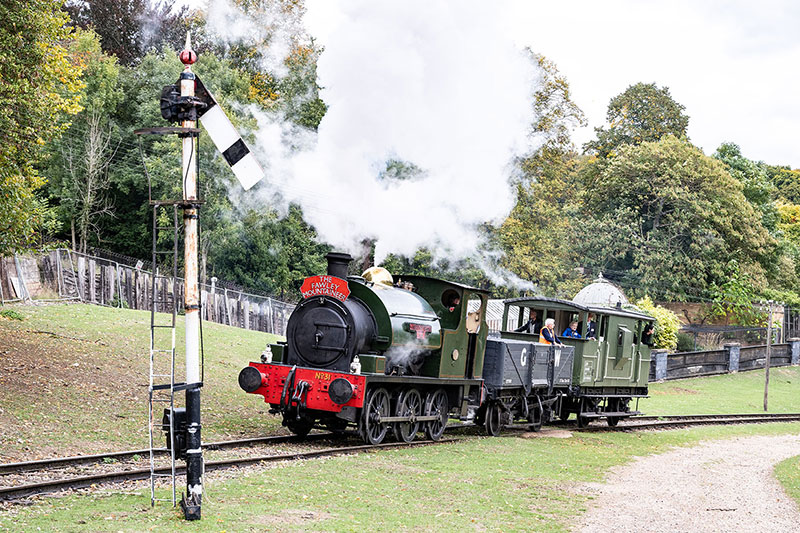
No 31 climbing the 1in 13 gradient at Fawley Hill
Thankfully, the overhaul was tendered for and won by our contractors Pete and Ali at Didcot. An agreement with the Great Western Society followed swiftly after as to the use of the works at Didcot as well. The strong links between Fawley Hill and Didcot are quite apparent and there are several volunteers that serve at both railways. The fact that the two venues are relatively close geographically also means that the Fawley volunteers are able to come and work on the loco.
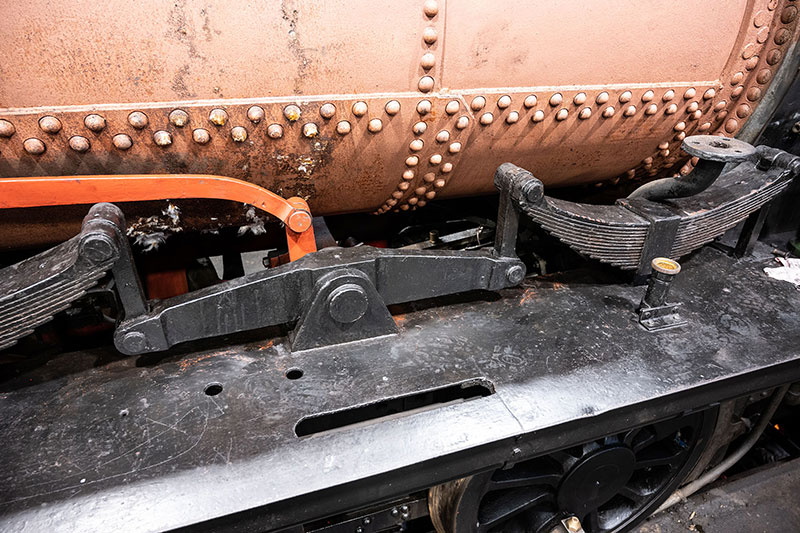
A close up of the compensated suspension
No 31 has amazingly been owned by a McAlpine in one way or another since her construction. She was ordered from Hudswell Clarke way back in 1913. By then the company had been in existence for about 53 years, having been founded in 1860. They had been known variously as Hudswell and Clarke, Hudswell, Clarke and Rodgers (1870), Hudswell, Clarke and Company (1881) and finally became a limited company in 1899.
They weren’t just a locomotive builder either. They worked on prototypes of compartment boats which were an early form of freight carrying inland waterway vessels. Mining equipment was also in their inventory including pit props and other hardware. They ended up being responsible for constructing the casings for munitions in WWII and even post-war nuclear weapons such as the Blue Danube and parts for the Centurion main battle tanks.

During No 31’s previous visit to Didcot, in 2019, she is climbing the coal stage – not so steep as her home incline at Fawley!
On the railway front, they were limited in standard gauge at least to the smaller and industrial scale machines. 0-6-0 and 0-4-0 designs being the most common. This they did successfully for many years. They also built diesel locomotives that were used in a variety of industrial scenarios including underground in the mining industry. They built a range of narrow gauge machines, both steam and diesel. One of the most famous of the diesel versions are those that still operate today on the 20” gauge Scarborough North Bay Railway and the 21” gauge Pleasure Beach Railway at Blackpool. These are unusual in that they look externally like main line steam locomotives. They are in fact diesel hydraulic machines and are amongst the earliest versions of this power train in use on UK railways.
No 31 is a small, 0-6-0 saddle tank contractor’s locomotive that is typical of the designs of the early twentieth century. She is simple, rugged and easy to look after as suits this purpose. One of the remarkable features of the engine is the suspension. It is fully compensated and when you watch her go along you get the feel that she would go over a ploughed field! If you are watching her as she moves, it is much like watching the suspension on an off-road vehicle. Every bump is soaked up effortlessly and the ride from the cab, even at the maximum permissible preserved line speeds, is very smooth.
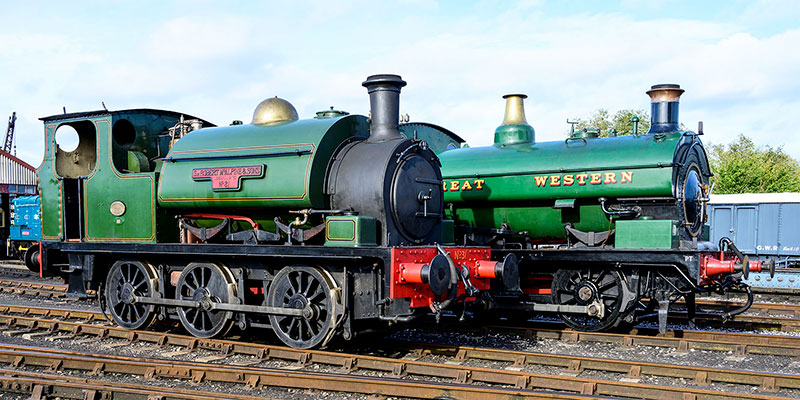
No 31 with Port Talbot Railway No 813, also built by Hudswell Clarke, at Didcot in 2019
She has Stephenson valve gear as is typical in industrial locomotive design, operating valves for two inside cylinders which are 15” diameter by 20” stroke. She has 3’ 7” diameter driving wheels and a tractive effort of 14,232 lbs force. Not bad for a little engine that weighs no more than 26 tons. Another remarkable feature of the engine is the efficiency and effectiveness of her braking system. This loco always performs incredibly well in this regard which is very fortunate when you consider that she works the steepest adhesion worked incline that we know of at Fawley Hill – an amazing 1:13 at its toughest!
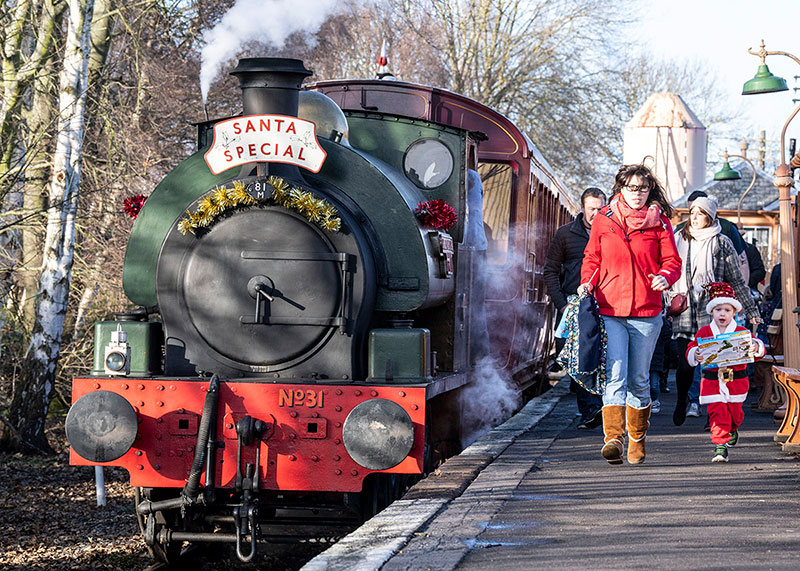
No 31 working Santa Specials at Didcot in December 2019, and displaying the 81M shed code plate
No 31 was originally ordered by the Ministry of Fuel and Power but was delivered when completed to the Robert McAlpine & Sons depot at Cuffley in the southeast of Hertfordshire between Cheshunt and Potters Bar. She was painted in the company livery of Caledonian Blue which she was to remain in for her entire working life. She was used on a series of famous construction projects in her time. The Empire Exhibition and Stadium Complex at Wembley (1923-1924), RAF Boscombe Down (1944) and Llanwern Steelworks (1960-1961) were just a few examples. She was sent back to her builders in 1938 and the engine was extensively rebuilt. One of the biggest visual changes was the swapping of the saddle tank from a squarer original to the curved version she has today.
No 31 worked until 1961, after which she was put into store at the McAlpine yard at Hayes, west London. She went on the scrapping list in 1965 and that should have been that if it were not for a certain member of the McAlpine Family – The Hon William (as he then was) – spotting the engine and her plight. Like so many things railway, she was delivered to Fawley in September 1965 to be preserved. There wasn’t much of a railway at Fawley at the time and the solution to get the engine to her new home was nothing short of cartoon-like.
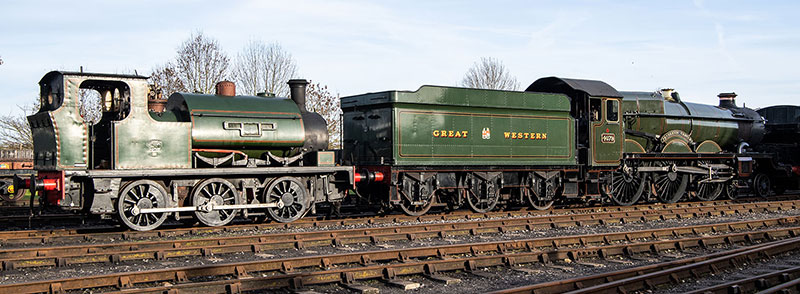
On 28 January 2024, No 31 was briefly coupled to Pendennis Castle when being shunted into the Lifting Shop
Remember if you will, that bit in the fantastic Wallace and Gromit film The Wrong Trousers – the bit when the train is going along the floor. Gromit is desperately laying track ahead of it to allow it to continue.
In a similar action, No 31 ventured off across the fields of the Fawley Estate on a couple of track panels. Rolling from the first to the second, the first then moved from behind to in front, and the whole process repeated until she was safe and sound! She was also repainted into Sir William’s favourite livery of GWR Middle Chrome Green with all the lining, a livery that has remained with her to this day. The shed at Fawley was also given its own shed code in the same style as the British Railways codes in use at the time. 81 was used as the number, as Fawley is near Henley-on-Thames and this puts it in the London Division of the former Great Western*. The letter code could only be M for McAlpine though. Thus she proudly carries the 81M shed code plate to this day.
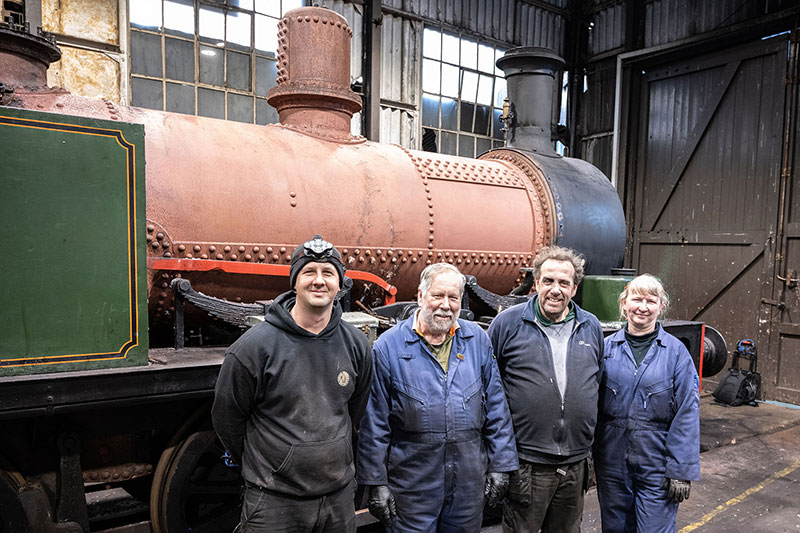
On 3 February 2024, with the tank lifted off the boiler, Leigh Drew (left) Didcot’s Locomotive Manager is with three volunteers from Fawley Hill Museum, left to right Tim Breeze, Nigel Parker and Di Breeze
She needs a thorough inspection and will get a boiler overhaul and will be thoroughly inspected mechanically and repaired as well. She is also long overdue for a repaint and if there’s anywhere she is likely to come out of the works in Great Western Livery, I suppose it’s Didcot! The engine has had a thorough boiler washout using our high pressure gear and is being dismantled in order for the inspection and overhaul to commence. I will keep you up to date with the progress of this historic machine.
*The same as Didcot which was 81E under BR.
09 FEBRUARY
Let’s Watch the Trailers
Given that we are on the build up to the return of the pioneer Great Western Society locomotive, No 1466, I thought we had better watch the trailers. They come before the main show, right? I am of course not referring to the lurid advertisements of Hollywood’s latest blockbuster. I’m referring of course to auto-trailers. Depending upon how you look at it, we either have three or four in the collection at Didcot. We will explain that in a future chat .…
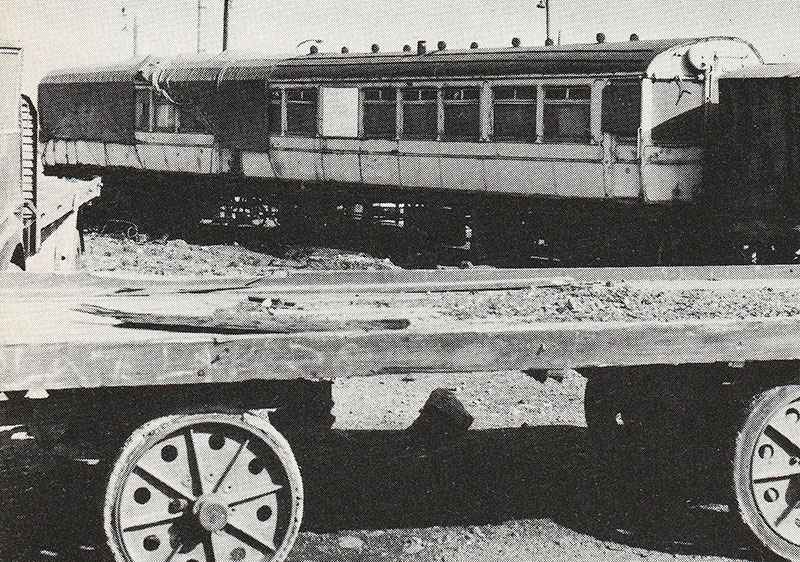
No 92 as first seen by preservationists, in use as a mess room at Cardiff docks
The first Great Western Railway auto-trailer was built in 1903. They were built in the matchboard style with the sides of the coach made up of thin, vertical planks of wood. They also had Dean type centreless bogies. This meant that the wheeled trucks under each end of the vehicle were supported on arms sticking out of the sides of the body rather than on a central pin. It is thought that these early vehicles were to be used with the then new steam railmotors of the same design then being built at Swindon.

No 92 had to be lifted and turned through 90 degrees to be reunited with the track before movement for preservation
The design of both the railmotors and their associated trailers progress with the technology and styles of the time. The match boarding went out early on and was replaced with the more familiar wood-panelled style. The sides were covered with a sheet of wooden panelling and where the joins occurred, wooden mouldings were fixed. This gave their outsides an intricate and complex appearance, enhanced by lining out.
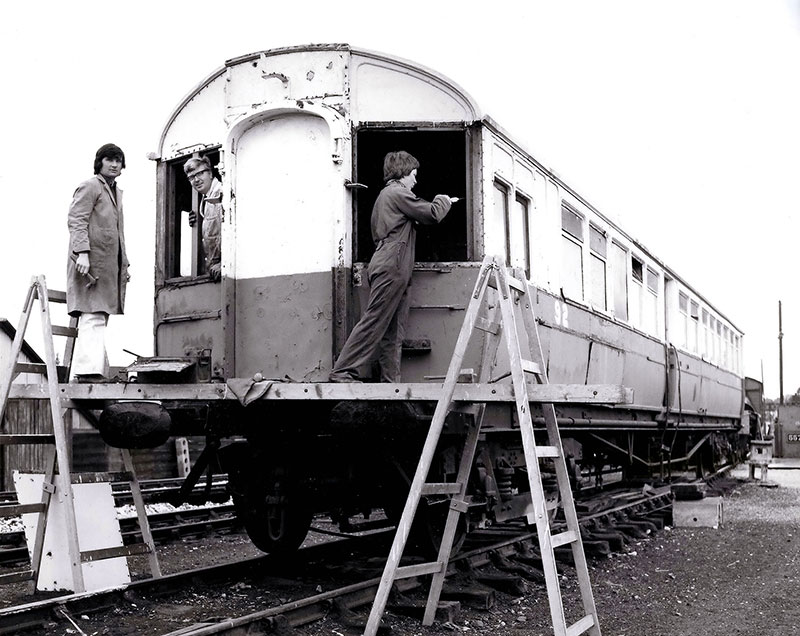
No 92 at Taunton in 1976
The centreless bogies also gave way fairly early on, too. The centre pin variety being much easier to produce and maintain. The diagram U coaches, of with our very own No 92 is a member, sported what was known as the ‘American’ bogies. These were, not unsurprisingly, based on American practice of the time and employed a clever equalising beam arrangement to supply the suspension. They were available in both 8 or 9 feet wheelbase versions although the latter was more typical for trailers.
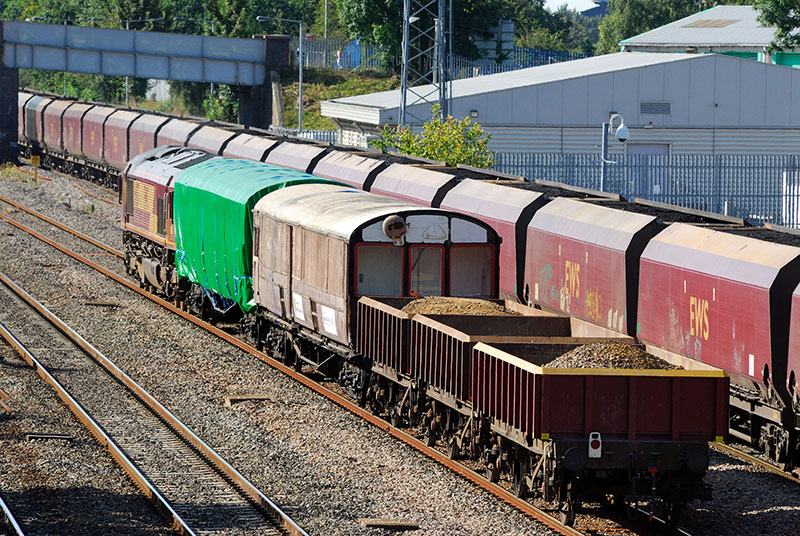
After the award of a Heritage Lottery grant for restoration of the railmotor and trailer, they moved to Llangollen for the work to be carried out. 92 is nearer the camera, 93 is under the green cover
By the time No 92 was built in September 1912, the designs had in some versions grown in size too. The railmotors and trailers were now 70 feet long and 9 feet wide. The internal layout became fairly standard. Going from the end that attached to the locomotive, there was usually a luggage compartment, a small seating area, the passenger doors, a large passenger compartment and then the driver’s cab at the far end. The seats in the diagram U trailers were of the tram or walkover type that could be easily rearranged so that the passengers could sit in the direction of travel.
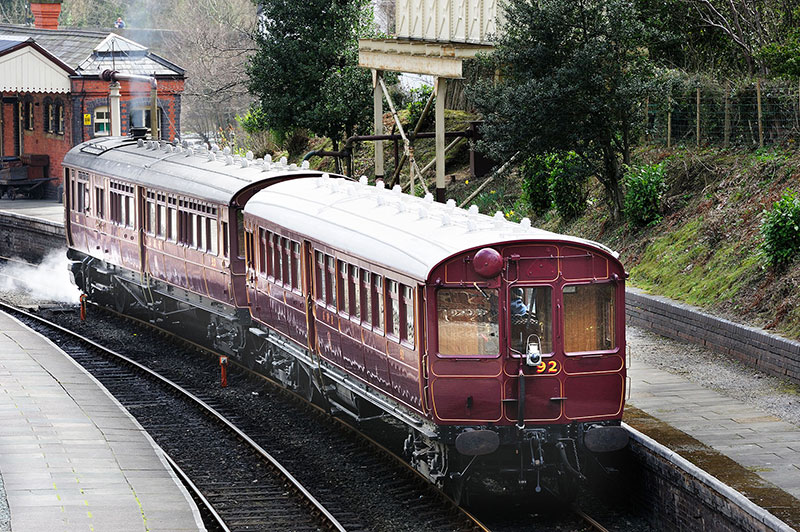
The SMU (Steam Multiple Unit) coupled together for the first time at Llangollen in April 2013, after restoration. The train can be driven either from the railmotor, or the cab at this end of No 92
An unusual feature of the diagram Us was the fact that they had corridor connections at the locomotive end of the coach. In theory this enabled them to be coupled to railmotors also so equipped but this was not done very often as railmotors thus equipped were even rarer! The corridor connections were not for the convenience of passengers, but allowed the guards through to check tickets.
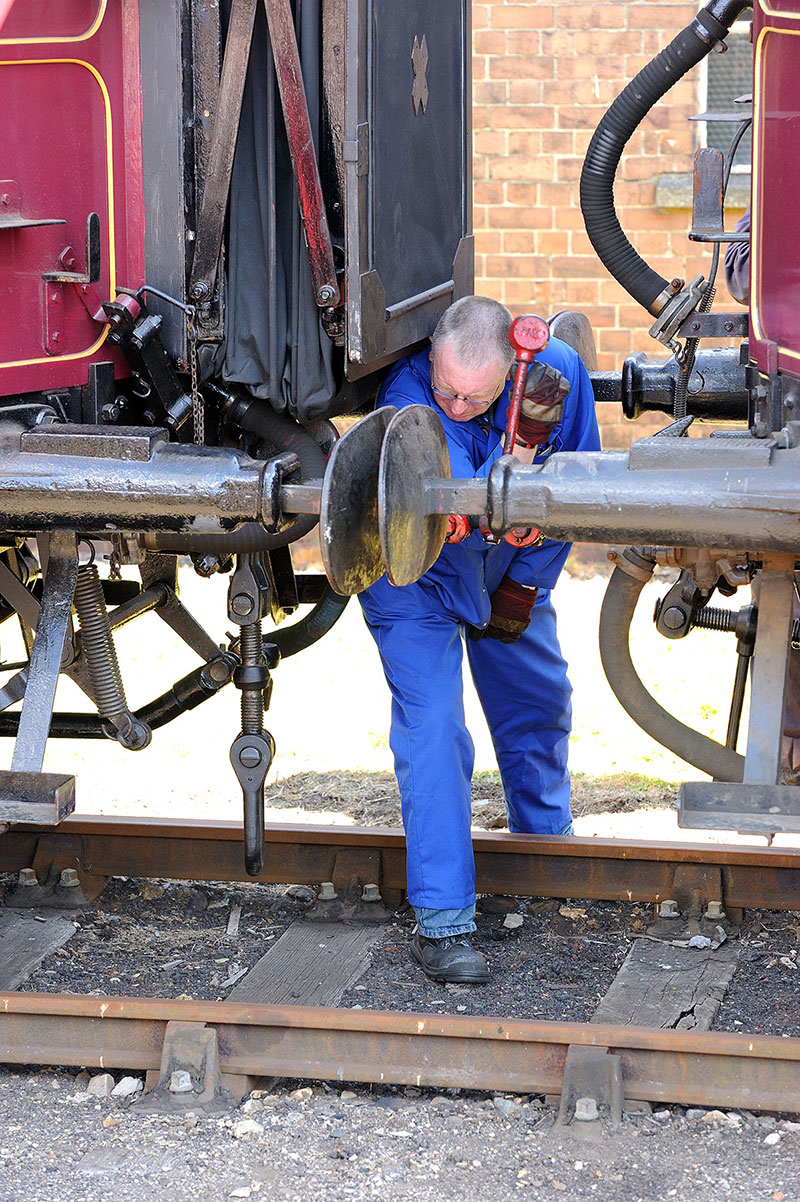
Coupling 92 and 93 together, showing the corridor connection at the end of 92
They were all gas lit from new, although the march towards the elimination of gas lighting on the railway caught up with No 92 in October 1931. These trailers were very long lived and lasted well beyond the demise of their railmotor partners who were all gone pretty much by the mid 1930s.

Showing off the gas lights (now converted to electricity) while in a tunnel on the Llangollen Railway
As they aged, their beautiful panelling became somewhat compromised in some cases. As the sections became damaged or deteriorated, they were unceremoniously replaced with plain steel panels. This could make these grand old vehicles look decidedly down at heel.
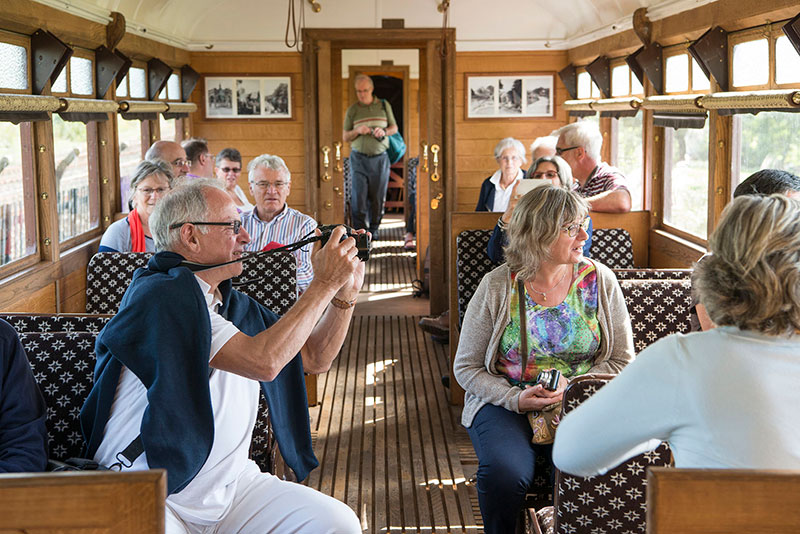
Inside No 92 at Didcot Railway Centre
The diagram U trailers began to be withdrawn in the mid 1950s but the last one in service, No 91, lasted into the early 1960s. Our example, No 92, was condemned in January 1957 and that should have been that but it was used as a mess room for staff from GKN at Cardiff Docks. From here it was noticed by members of the Great Western Society and eventually purchased in 1969.
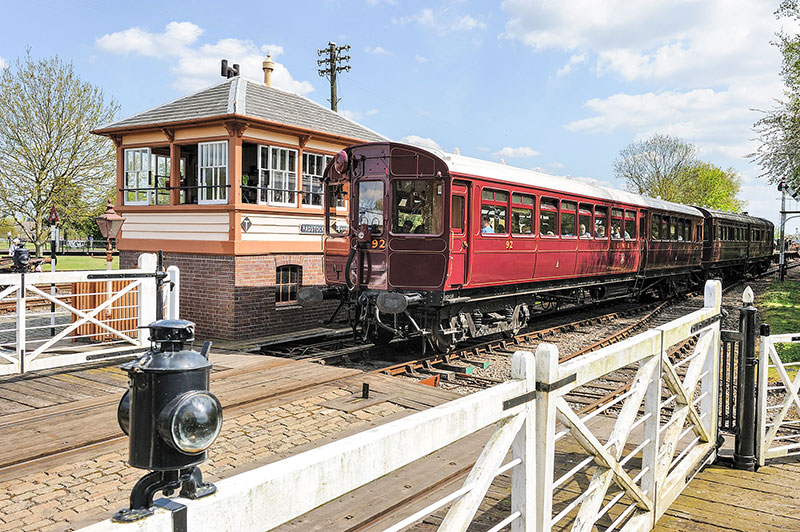
The SMU passing Radstock signal box at Didcot Railway Centre
It moved from Cardiff to Swindon initially but migrated to the depot at Taunton in 1972 and thence to Didcot in 1977. It was cosmetically restored from then and used as staff accommodation. Eventually, the idea to rebuild the railmotor came to the fore and as part of the Heritage Lottery application, it was proposed to rebuild No 92 as the perfect partner to Railmotor No 93. The numbers are even sequential – clearly it was meant to be! No 92 now serves as a fantastic reminder of those early auto trailers and is a unique survivor of its type. To step on board is to step back in time and that’s exactly our aim at Didcot. Mission accomplished!
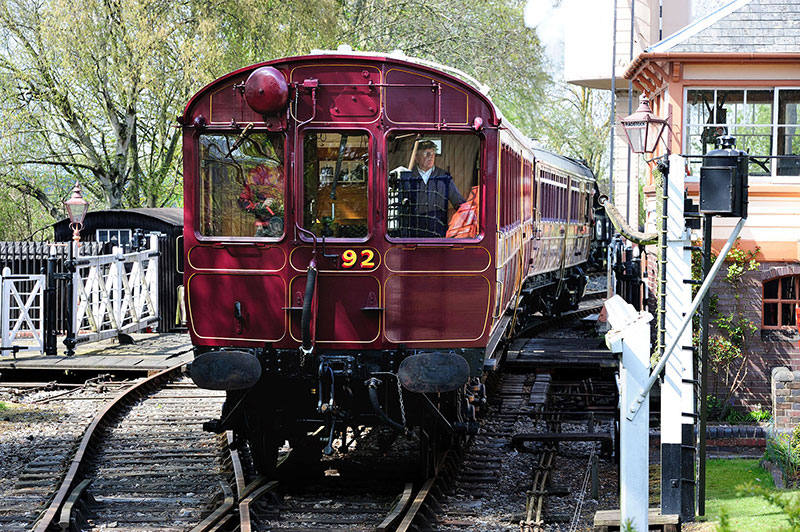
The SMU passing Radstock signal box
The auto-trailer that isn’t an auto-trailer next time .…
02 FEBRUARY
The Lucky Thirteen
We talked about No 1363 a LONG time ago in Going Loco. Some of the earliest blogs were on this engine * and while we have covered quite a bit of the engine’s history since she was built in 1910, the current restoration and overhaul has escaped us. Until now .…
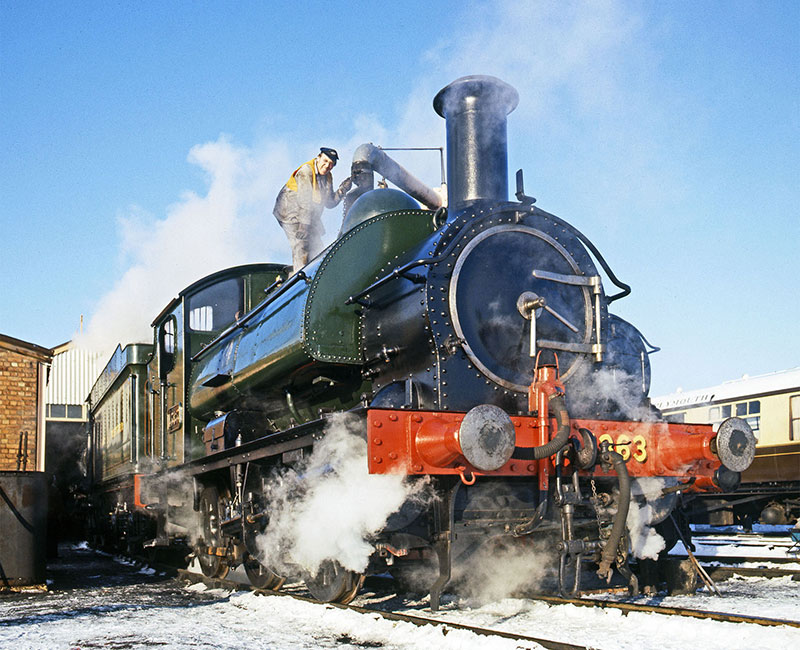
1363 taking water in the snow, 1 January 1979
The locomotive hasn’t been steamed since the early 1980s. She was also nearly a century old when the current overhaul started so she has been through a thing or two .… As she hadn’t been touched in so long, she really was an unknown quantity both structurally and mechanically. Only stripping her down would reveal the extent of the work required to bring her back to life. Let’s just say, the answer was that there was a fair bit to do .…
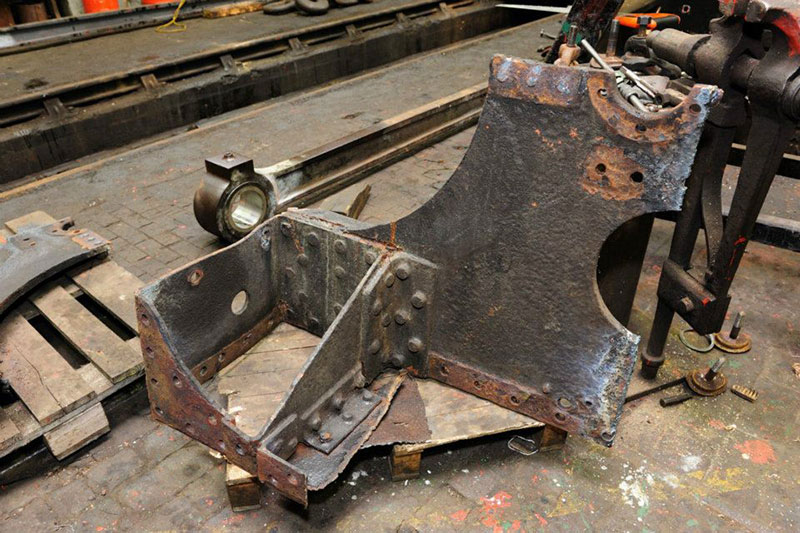
Part of the original frames (upside down) after being cut away, showing the corroded state
The first bit noticed was the fact that the main frames and practically everything else around the cab area was in pretty poor condition. Most of the metal here looked exactly like it was a century old. The steel was thin and dented. Certainly no longer capable of being part of an operational steam locomotive. This rot went right down to the main frames of the engine. In places these were wasted through corrosion to less than half of their original thickness. Considering that this section is where the main brake shaft and the drag box where the coupling to the train goes, it’s an area that needs to be fairly durable .…

Riveting the replacement section of frames
The rear three feet of the frames were replaced in the end. The only major parts that were reused here were the cab steps and the fittings such as the buffers, vacuum pipes, brake shaft and so on. The rest is all new. This replacement programme has continued up from the rear frames. The bunker, in its entirety, was also very badly wasted. The bunker itself had a huge crease in it from a coming together with another rail vehicle sometime in the dim and distant past. The cab floor was in an equally poor condition too and has also been replaced. The cab sides and the front are the originals however. The sanding mechanism was also in pretty poor condition and has been overhauled throughout. The front drag box had been repaired a few times and was no longer fit for service. This is also now new.
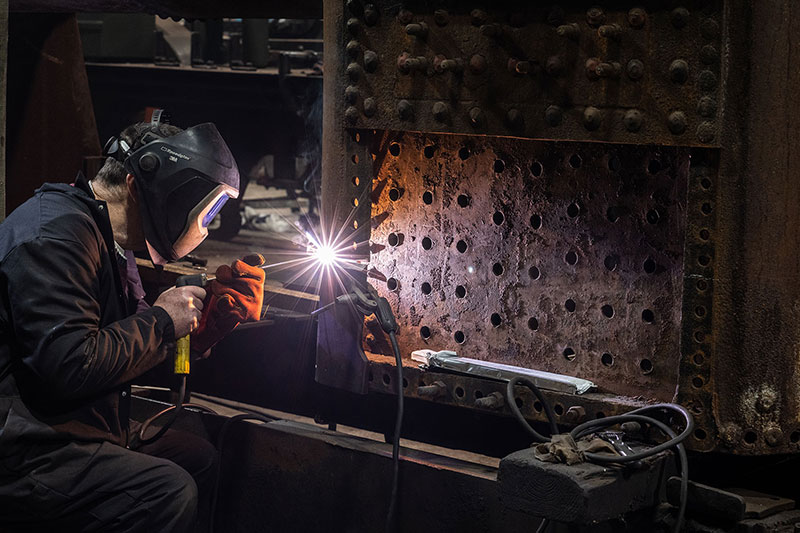
The new part of the outer firebox throatplate being welded
The boiler has needed extensive repairs. The lower sections of the steel outer firebox were thinned to beyond acceptable limits and have been cut out. The process for doing this is quite involved. The tricky bit here being that the side panels are on top of the front and rear panels. This means that you have to remove a small portion of the side panel each end to get the front and rear sections off. The remains of the side panels hold the inner firebox and foundation ring in position while the new sections are welded in front and rear. These are then riveted in place and the remains of the side panels cut away and new sections welded in and riveted back together. It’s quite the job .…
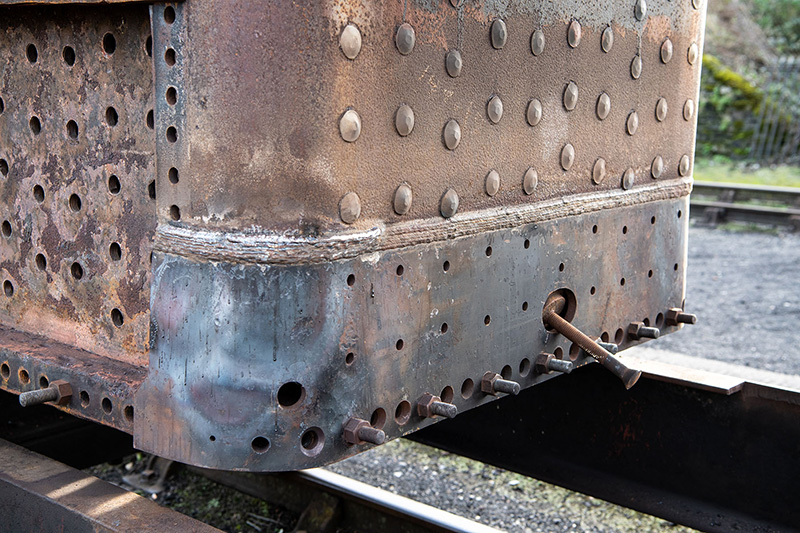
The lower part of the throatplate in position, with the welded joint
A number of stays (the things that hold the inner and outer firebox together and prevent the plate work bending under the pressure) have needed replacement as well as the front tube plate. This is the flat panel at the front end of the boiler and, as its name suggests, it has holes for the boiler tubes and a few other items in it.
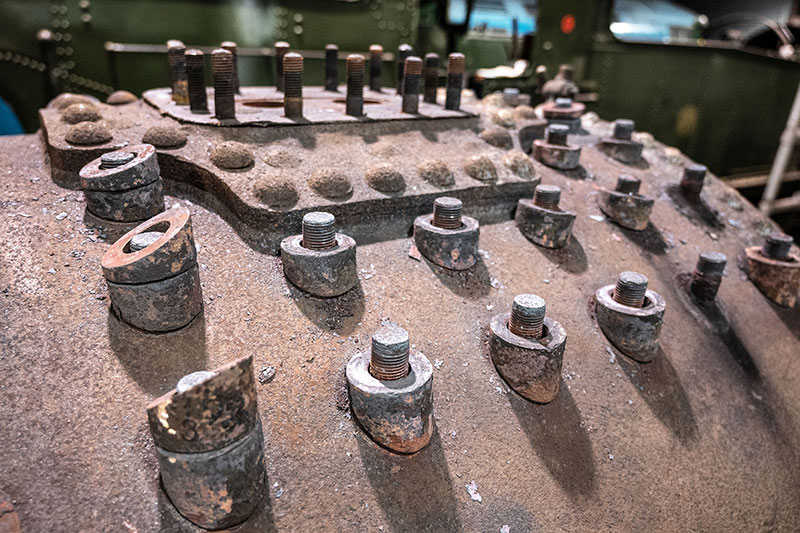
The crown stays are being replaced. They are caulked, then nutted, but to take account of the shape of the firebox, spacers are fitted between the nuts and firebox top

Each spacer is individually shaped and identified for its position with a code of numerals and dots. The spacers are cast in bronze and two of them have been polished for this portrait
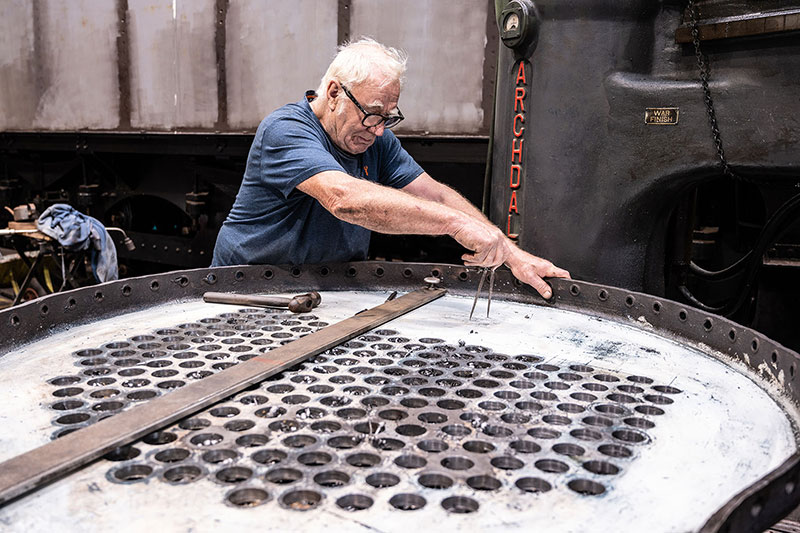
The front tubeplate being marked out by Pete Gransden
Mechanically, the engine was also very tired. The list of parts refreshed or replaced is extensive. The main wheel bearings were the start of it all so that she could sit back on her wheels again. Whilst the wheels were out, the tyres were turned to restore the flange profile back to standard. All of the other white metal bearing surfaces have been replaced. This means the cross heads, the rod bearings and so on. The pins that hold the rare Allen straight link valve motion together were all renewed and the die blocks replaced too. The slide valves were found to be in good condition but the pistons required new rings to be manufactured and fitted.
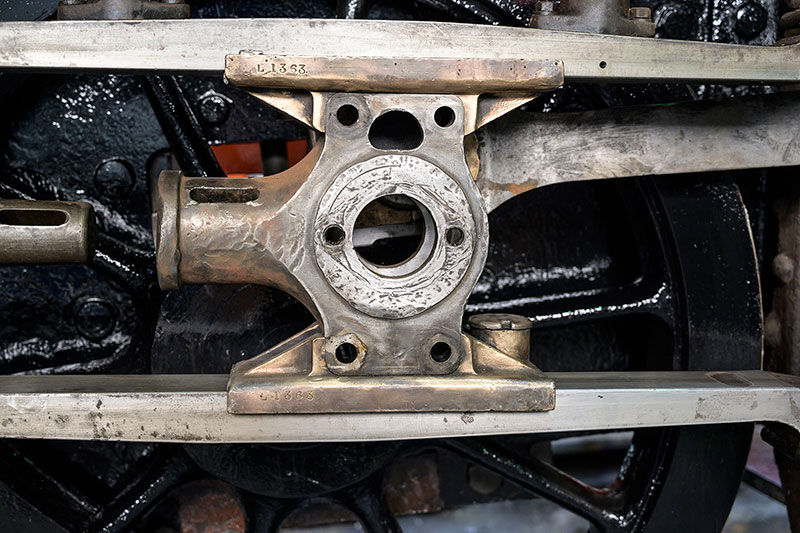
One of the crossheads stamped with the loco’s number
The cylinders were still in good order and the overhaul uncovered the fact that the cylinders on the engine are not a matching pair. It is thought that one of them is a replacement that is of the same design as the later pannier version of the design. The upshot of this is that despite there being a 1361 class locomotive in preservation, there is only one surviving cylinder to that design! No 1363 also needed to have her suspension overhauled. The team found that there were several pins and other parts that were seized in place and required some quite determined removal(!). All of the pins were replaced and the springs were sent away to be remanufactured back to their original tolerances.

The new cab roof being fitted by Angus Pottinger (left) and Chris Handby (right)
The final big item for the overhaul will be the saddle tank itself. This is what makes the locomotive unique. She is the only saddle tank built at Swindon to survive in preservation. The problem with the tank is that it is quite a complex design with a series of overlapping and highly curved steel plates. An investigation carried out by cutting out a section known to be too thin has shown that the lower tank is in far worse condition than the upper section. The team working on her have a plan, but it’s not going to be a simple repair.
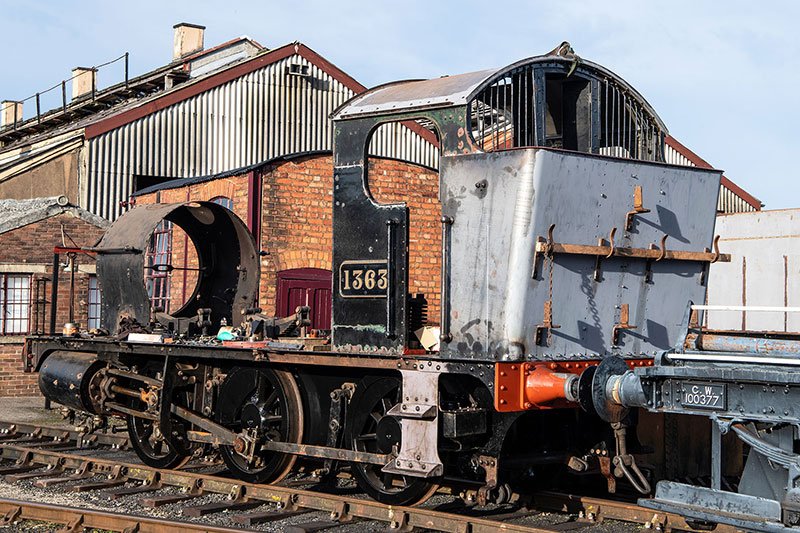
1363’s chassis outside the engine shed on 28 January 2024, with the cab sides and roof and the new bunker fitted
The team working on her have had made amazing progress recently and a project that took a back seat for a number of years while Castles, Saints and Kings ** were completed. It’s now time for this plucky survivor to come to the fore. It will be a great day when ‘the big thirteen’ steams again and she will be a fantastic thing to see. The oldest Swindon-built engine in our collection. A genuine machine produced in the white heat of Churchward’s technological advances and yet a strange anachronism in that she was based on a design that went back over 50 years when she was built.
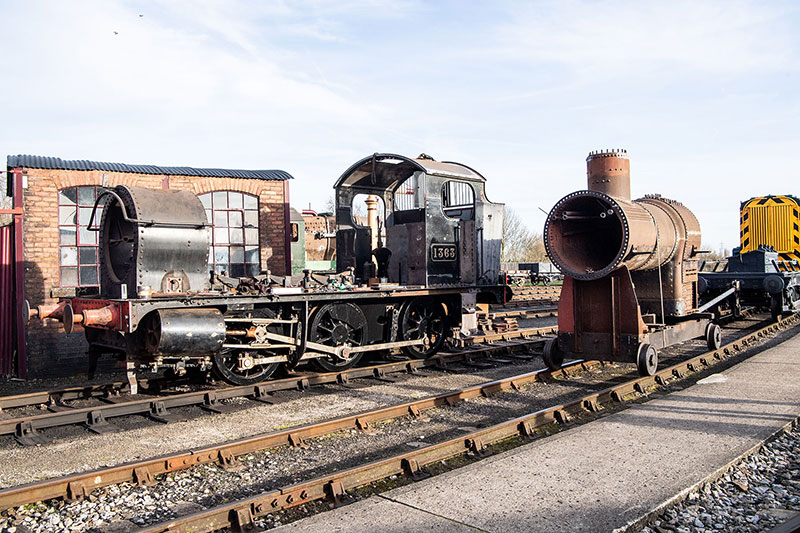
1363’s chassis with the boiler alongside on its trolley, outside the engine shed during a rearrangement of the lifting shop and loco works on 28 January 2024
She is a lot of things to a lot of people, but the one thing she definitely is, is a rare insight into the small engines of the Great Western before the era of dominance of the pannier tank.
* 24 April 2020 and 12 June 2020
** Our little 0-6-0T King George, not the other one!
 |
 |
 |
 |
Didcot Railway Centre Newsletter
Stay up to date with events and what's going on at Didcot Railway Centre.
You may unsubscribe at any time. We do not share your data with 3rd parties.